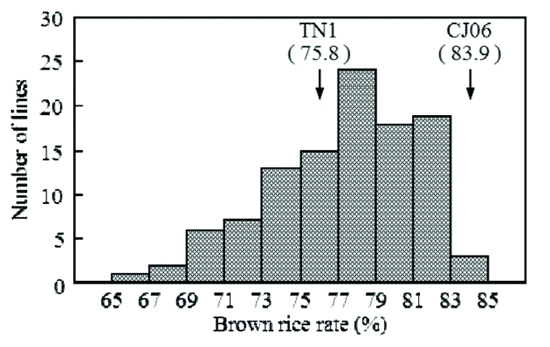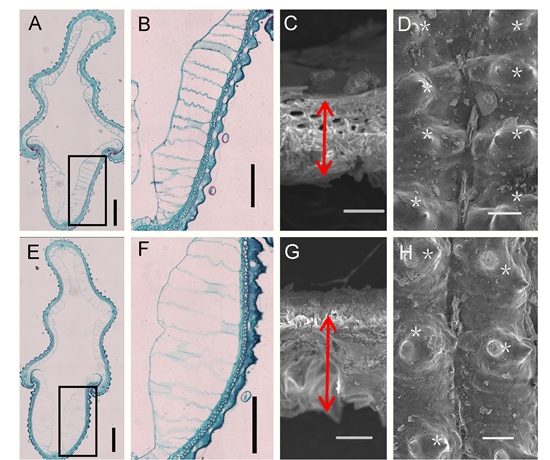分享到
Progress on Genetic Mechanism of Rice Yield
Rice grain consists of an inner brown rice (edible part) and a hull (inedible part) reciprocally interlocked by the lemma and palea. Converting photosynthetic products to people edible part or brown rice as far as possible was one of the effective methods to increase the "output" of rice. Brown rice rate (BRR) is a key factor ensuring grain yield and quality in rice. Therefore, increasing the grain BRR or decreasing the hull percentage played an important role in improvement of the actual grain yield.

In recent study conducted by scientists from China National Rice Research Institute from Chinese Academy of Agricultural Sciences, 4 QTLs were detected in Hangzhou and Hainan to control the BRR using the DH population. With the BC4F2 progenies derived from the cross between CSSL1-2 and CJ06, a new major QTL (qBRR-10) for the BRR, was fine mapped within 39.5 kb physical interval on chromosome 10. Two candidate genes were finally selected based on the difference in the transcriptional expression. The cloning and genetic mechanism study of the qBRR-10 will facilitate increasing the BRR and further improving rice yield and milling quality.

Histocytological analysis of hulls in CJ06, TN1
This work was supported by grants from the National Natural Science Foundation of China, and the China Postdoctoral Science Foundation (2014M561108). The research result has been published online on Rice on February 2016 (Doi: 10.1186/s12284-016-0076-7). More details are available on the link bellow:
http://www.ncbi.nlm.nih.gov/pmc/articles/PMC4742455/

The distribution of brown rice rate in the DH population
In recent study conducted by scientists from China National Rice Research Institute from Chinese Academy of Agricultural Sciences, 4 QTLs were detected in Hangzhou and Hainan to control the BRR using the DH population. With the BC4F2 progenies derived from the cross between CSSL1-2 and CJ06, a new major QTL (qBRR-10) for the BRR, was fine mapped within 39.5 kb physical interval on chromosome 10. Two candidate genes were finally selected based on the difference in the transcriptional expression. The cloning and genetic mechanism study of the qBRR-10 will facilitate increasing the BRR and further improving rice yield and milling quality.

Histocytological analysis of hulls in CJ06, TN1
This work was supported by grants from the National Natural Science Foundation of China, and the China Postdoctoral Science Foundation (2014M561108). The research result has been published online on Rice on February 2016 (Doi: 10.1186/s12284-016-0076-7). More details are available on the link bellow:
http://www.ncbi.nlm.nih.gov/pmc/articles/PMC4742455/
By Yuan Yiqing
Yuanyiqing@caas.cn
Yuanyiqing@caas.cn
Latest News
-
 Apr 18, 2024Opening Ceremony of the Training Workshop on Wheat Head Scab Resistance Breeding and Pest Control in Africa Held in CAAS
Apr 18, 2024Opening Ceremony of the Training Workshop on Wheat Head Scab Resistance Breeding and Pest Control in Africa Held in CAAS -
 Apr 03, 2024IPPCAAS Co-organized the Training Workshop on Management and Application of Biopesticides in Nepal
Apr 03, 2024IPPCAAS Co-organized the Training Workshop on Management and Application of Biopesticides in Nepal -
 Mar 28, 2024Delegation from the School of Agriculture and Food Science of University College Dublin, Ireland Visit to IAS, CAAS
Mar 28, 2024Delegation from the School of Agriculture and Food Science of University College Dublin, Ireland Visit to IAS, CAAS -
 Mar 25, 2024Director of World Food Prize Foundation visited GSCAAS
Mar 25, 2024Director of World Food Prize Foundation visited GSCAAS -
 Mar 20, 2024Institute of Crop Sciences (ICS) and Syngenta Group Global Seeds Advance Collaborative Research in the Seed Industry
Mar 20, 2024Institute of Crop Sciences (ICS) and Syngenta Group Global Seeds Advance Collaborative Research in the Seed Industry
